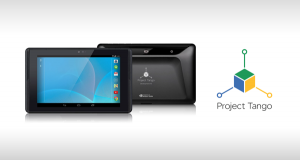By Anca Gagiuc on April 30, 2015 in Technology
Google likes to play, and the company’s innovative ATAP group has been toying with a 3D-mapping project that would enable hardware to approximate with the same visual acuity of the human eye. The feature was already available in autonomous robots and military research labs, but Google’s Advanced Technologies and Projects division wants to make it available to everyone.
Project lead Johnny Lee and his team intend to break the boundaries of mobile devices, currently limited to their own screens, and extend to them th e human-scale understanding of space and motion. The mission is to build mobile devices capable of using depth sensors and high-spec cameras to craft three-dimensional maps more cheaply and easily than existing efforts.
e human-scale understanding of space and motion. The mission is to build mobile devices capable of using depth sensors and high-spec cameras to craft three-dimensional maps more cheaply and easily than existing efforts.
In collaboration with universities, research labs, and industrial partners, the team has built prototypes and shared them with developers who can imagine a wide range of possibilities and work on bringing those ideas into reality. So far ATAP released two pieces of hardware: a prototype smartphone equipped with Kinect-like 3D sensors and other components and a more powerful seven-inch tablet.
The tablet has a 1080p display that runs on Android 4.4 KitKat powered by NVIDIA’s quad-core Tegra K1 chip next to 4GB of RAM and 128GB internal storage, without microSD slot. Additionally it features USB 3.0, micro-HDMI, Bluetooth LE and LTE. The Tango tablet was built with a depth sensor on the back and two cameras: one has a 4MP sensor capable of offering high light sensitivity and fast speeds, and the other tracks motion more broadly with a 170-degree wide-angle fisheye lens.
Designed with developers in mind, the tablet doesn’t focus on aesthetics, but doesn’t disregard it completely. The cameras are mounted at a 13-degree angle to give the needed view for gathering accurate data without having to hold the tablet directly in front of their faces when mapping a room.
Imagine the multitude of uses of this technology: virtually touring an apartment in New York from your home in California in a very realistic way; analyzing how that new sofa would look in your living room without using tape measures or trying to picture how it would look like; three-dimensional maps easing the life of the visually impaired users; turning your living room into a dungeon to have a deeper sense of the game you’re obsessed with playing right now.
Johnny Lee believes that even though at the time being the technology is at its very early stages, it will become a feature as used and as popular as the Bluetooth is in today’s smartphones. Research and work in the 3D-mapping space has been ongoing for the past 20 years and Tango has reached the point where it focuses on condensing all that technology into a small enough device easy to carry around.
The Tango tablet is not yet a consumer device, but one meant for developers simply because none of the above mentioned uses of this technology would be possible without the creative input of developers. His team predicts a bright future for it and not just in smartphones and tablets, and extending to wearables as well.


